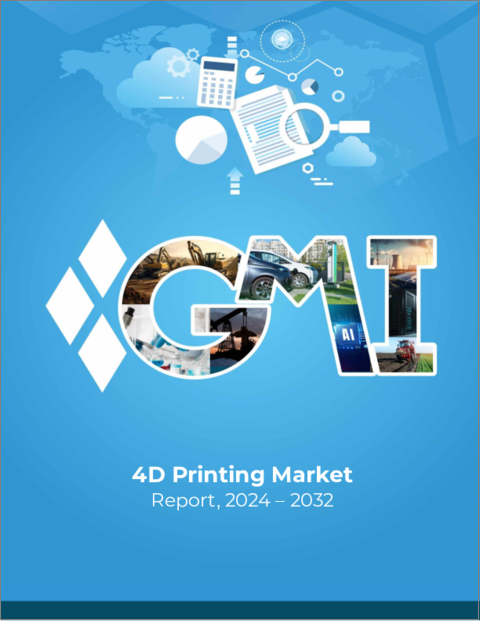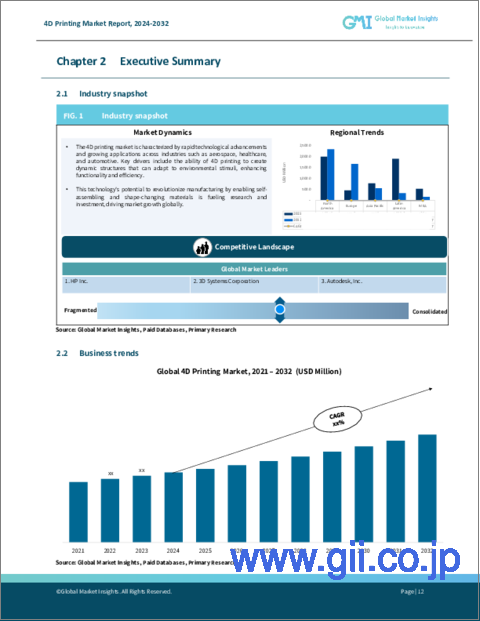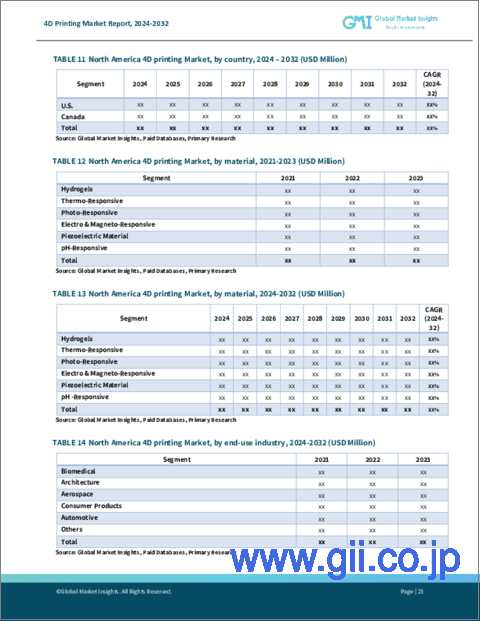|
|
市場調査レポート
商品コード
1518512
4Dプリンティング市場:材料別、最終用途産業別、予測、2024年~2032年4D Printing Market, By Material (Hydrogels, Thermo-responsive, Photo-responsive, Electro & Magneto-responsive, Piezoelectric Material, pH-responsive), By End Use Industry & Forecast, 2024 - 2032 |
||||||
カスタマイズ可能
|
|||||||
| 4Dプリンティング市場:材料別、最終用途産業別、予測、2024年~2032年 |
|
出版日: 2024年04月26日
発行: Global Market Insights Inc.
ページ情報: 英文 200 Pages
納期: 2~3営業日
|
全表示
- 概要
- 目次
世界の4Dプリンティング市場は、材料科学、特に刺激応答性材料の開拓の進展と、航空宇宙、ヘルスケア、自動車などの産業にわたる用途の拡大により、2024年から2032年にかけてCAGR 40%に達します。
この技術は、環境の変化に適応したり、複雑なタスクを自律的に実行したりできる、動的で応答性の高い構造の創出を可能にします。さまざまな分野でカスタマイズされた機能的なデザインへの需要が高まるなか、4Dプリンティングは効率性を高め、コストを削減し、製品開発と製造に新たな道を開く革新的なソリューションを提供します。
例えば、2024年1月、クイーンズランド大学(UQ)の研究者は、ソフトロボット用途のために形状を変化させる液体金属を作成する新しい4Dプリンティング技術を開拓しています。この技術革新は、製造や生物医学分野といった従来の用途を超え、ロボット工学のための動的で適応性のある材料へと、この技術の潜在的用途を拡大するものです。この技術革新は、印刷材料の機能性と柔軟性を向上させる傾向が強まっていることを強調するものであり、世界中の多様な産業および研究用途における4D印刷技術への関心と投資を促進するものです。
建築は2032年まで著しい成長を遂げると思われます。自己組み立てや時間経過による適応が可能なプログラム可能な材料を利用することで、4Dプリンティングは建築家にこれまでにない設計の柔軟性と効率性を提供します。用途としては、カスタマイズ可能な建築部品、適応性のあるファサード、環境の変化に対応できる構造などがあります。材料科学と積層造形技術の進歩が進むにつれて、建築分野はこれらの能力を活用して革新的で持続可能、かつ応答性の高い建築環境を創造し、4Dプリンティング市場の成長に拍車をかけると思われます。
熱応答性セグメントは2024年から2032年の間に大幅な上昇を示すことになり、温度変化に応答する能力によって推進され、自己組織化と形状変換を可能にします。医療、航空宇宙、建築などの用途では、環境条件に適応するスマート材料の需要が高まっており、熱応答性材料は市場成長の主要な貢献者となっています。材料科学と工学の進歩に伴い、これらのイノベーションは、多様な産業にわたって効率性と機能性を高めるダイナミックな機能を提供することで、製造業に革命をもたらすと思われます。
欧州の4Dプリンティング産業シェアは、2024年から2032年にかけてまずまずのCAGRを示すと予想されます。この地域は、航空宇宙、ヘルスケア、自動車分野における革新的なアプリケーションに注力しており、4Dプリンティングの進歩の最前線に位置しています。熟練した労働力と規制環境の整った欧州は、4Dプリンティング市場の中心的存在として、世界の動向を形成し、ダイナミックな材料製造における技術革新を促進します。
目次
第1章 調査手法と調査範囲
第2章 エグゼクティブサマリー
第3章 業界洞察
- エコシステム分析
- ベンダー・マトリックス
- 利益率分析
- テクノロジーとイノベーションの展望
- 特許分析
- 主要ニュースと取り組み
- 規制状況
- 影響要因
- 促進要因
- スマートで応答性の高い構造を実現する材料の進歩
- 農業用途の生分解性ロボット工学の進歩
- カスタマイズ可能な自己組織化製品の需要
- 4DプリンティングとIoTおよびAI技術の統合
- 積層造形技術の採用増加
- 業界の潜在的リスク&課題
- 先端技術に対する労働力のスキル格差
- 材料の安定性と信頼性の課題
- 促進要因
- 成長可能性分析
- ポーター分析
- PESTEL分析
第4章 競合情勢
- イントロダクション
- 企業シェア分析
- 競合のポジショニング・マトリックス
- 戦略展望マトリックス
第5章 市場推計・予測:材料別、2018年~2032年
- 主要動向
- ハイドロゲル
- 熱応答性
- 光応答性
- 電気・磁気応答性
- 圧電材料
- pH応答性
第6章 市場推計・予測:最終用途産業別、2018年~2032年
- 主要動向
- バイオメディカル
- 建築
- 航空宇宙
- 消費者向け製品
- 自動車
- その他
第7章 市場推計・予測:地域別、2018年~2032年
- 主要動向
- 北米
- 米国
- カナダ
- 欧州
- 英国
- ドイツ
- フランス
- イタリア
- スペイン
- その他欧州
- アジア太平洋
- 中国
- インド
- 日本
- 韓国
- ニュージーランド
- その他アジア太平洋地域
- ラテンアメリカ
- ブラジル
- メキシコ
- その他ラテンアメリカ
- 中東・アフリカ
- UAE
- 南アフリカ
- サウジアラビア
- その他中東・アフリカ
第8章 企業プロファイル
- 3 D Systems Corporation
- Autodesk, Inc.
- EnvisionTEC
- EOS GmbH
- ExOne
- HP Inc.
- Materialise NV
- Organovo Holdings, Inc.
- SLM Solutions Group AG
- Stratasys Ltd.
Global 4D Printing Market will reach a 40% CAGR from 2024 to 2032 due to advancements in material science, particularly in developing stimuli-responsive materials, coupled with the expanding applications across industries like aerospace, healthcare, and automotive. This technology enables the creation of dynamic and responsive structures that can adapt to environmental changes or perform complex tasks autonomously. As demand grows for customized and functional designs in various sectors, 4D printing offers innovative solutions that enhance efficiency, reduce costs, and open new avenues for product development and manufacturing.
For instance, in January 2024, researchers at the University of Queensland (UQ) are pioneering new 4D printing techniques to create liquid metals that change shape for soft robotics applications. This innovation expands the technology's potential applications beyond traditional uses, such as manufacturing and biomedical fields, into dynamic and adaptive materials for robotics. It underscores a growing trend towards enhancing functionality and flexibility in printed materials, driving interest and investment in 4D printing technologies for diverse industrial and research applications worldwide.
The 4D printing industry is classified based on device, end-user vertical, application, and region.
The architecture will experience marked growth through 2032, attributed to its potential to revolutionize construction practices. By utilizing programmable materials that can self-assemble or adapt over time, 4D printing offers architects unprecedented design flexibility and efficiency. Applications include customizable building components, adaptive facades, and structures capable of responding to environmental changes. As advancements in material science and additive manufacturing continue, the architecture segment will harness these capabilities to create innovative, sustainable, and responsive built environments, thereby spurring growth in the 4D printing market.
The thermo-responsive segment will witness a substantial uptick between 2024 and 2032, propelled by its ability to respond to temperature changes, enabling self-assembly and shape transformation. Applications in medicine, aerospace, and construction drive demand for smart materials that adapt to environmental conditions, positioning thermo-responsive materials as key contributors to the market's growth. With advancements in material science and engineering, these innovations will revolutionize manufacturing by offering dynamic capabilities that enhance efficiency and functionality across diverse industries.
Europe 4D printing industry share will demonstrate a decent CAGR from 2024 to 2032, driven by robust research and development initiatives, supportive government policies, and strong investments in advanced manufacturing technologies. The region's focus on innovative applications in the aerospace, healthcare, and automotive sectors positions it at the forefront of 4D printing advancements. With a skilled workforce and a conducive regulatory environment, Europe will stand as the central contributor to the 4D printing market, shaping global trends and fostering technological innovation in dynamic material fabrication.
Table of Contents
Chapter 1 Methodology & Scope
- 1.1 Market scope & definition
- 1.2 Base estimates & calculations
- 1.3 Forecast calculation
- 1.4 Data sources
- 1.4.1 Primary
- 1.4.2 Secondary
- 1.4.2.1 Paid sources
- 1.4.2.2 Public sources
Chapter 2 Executive Summary
- 2.1 Industry 360 degree synopsis, 2018 - 2032
- 2.2 Business trends
- 2.2.1 Total Addressable Market (TAM), 2024-2032
Chapter 3 Industry Insights
- 3.1 Industry ecosystem analysis
- 3.2 Vendor matrix
- 3.3 Profit margin analysis
- 3.4 Technology & innovation landscape
- 3.5 Patent analysis
- 3.6 Key news and initiatives
- 3.7 Regulatory landscape
- 3.8 Impact forces
- 3.8.1 Growth drivers
- 3.8.1.1 Material advancements for smart, responsive structures
- 3.8.1.2 Advancements in biodegradable robotics for agricultural applications
- 3.8.1.3 Demand for customizable and self-assembling products
- 3.8.1.4. Integration of 4 D printing with IoT and AI technologies
- 3.8.1.5 Rising adoption of additive manufacturing techniques
- 3.8.2 Industry pitfalls & challenges
- 3.8.2.1 Skill gap in the workforce for advanced technology
- 3.8.2.2 Challenges in material stability and reliability
- 3.8.1 Growth drivers
- 3.9 Growth potential analysis
- 3.10 Porter's analysis
- 3.10.1 Supplier power
- 3.10.2 Buyer power
- 3.10.3 Threat of new entrants
- 3.10.4 Threat of substitutes
- 3.10.5 Industry rivalry
- 3.11 PESTEL analysis
Chapter 4 Competitive Landscape, 2023
- 4.1 Introduction
- 4.2 Company market share analysis
- 4.3 Competitive positioning matrix
- 4.4 Strategic outlook matrix
Chapter 5 Market Estimates & Forecast, By Material, 2018 - 2032 (USD Million)
- 5.1 Key trends
- 5.2 Hydrogels
- 5.3 Thermo-responsive
- 5.4 Photo-responsive
- 5.5 Electro & magneto-responsive
- 5.6 Piezoelectric material
- 5.7 pH-responsive
Chapter 6 Market Estimates & Forecast, By End-use Industry, 2018 - 2032 (USD Million)
- 6.1 Key trends
- 6.2 Biomedical
- 6.3 Architecture
- 6.4 Aerospace
- 6.5 Consumer products
- 6.6 Automotive
- 6.7 Others
Chapter 7 Market Estimates & Forecast, By Region, 2018 - 2032 (USD Million)
- 7.1 Key trends
- 7.2 North America
- 7.2.1 U.S.
- 7.2.2 Canada
- 7.3 Europe
- 7.3.1 UK
- 7.3.2 Germany
- 7.3.3 France
- 7.3.4 Italy
- 7.3.5 Spain
- 7.3.6 Rest of Europe
- 7.4 Asia Pacific
- 7.4.1 China
- 7.4.2 India
- 7.4.3 Japan
- 7.4.4 South Korea
- 7.4.5 ANZ
- 7.4.6 Rest of Asia Pacific
- 7.5 Latin America
- 7.5.1 Brazil
- 7.5.2 Mexico
- 7.5.3 Rest of Latin America
- 7.6 MEA
- 7.6.1 UAE
- 7.6.2 South Africa
- 7.6.3 Saudi Arabia
- 7.6.4 Rest of MEA
Chapter 8 Company Profiles
- 8.1. 3 D Systems Corporation
- 8.2 Autodesk, Inc.
- 8.3 EnvisionTEC
- 8.4 EOS GmbH
- 8.5 ExOne
- 8.6 HP Inc.
- 8.7 Materialise NV
- 8.8 Organovo Holdings, Inc.
- 8.9 SLM Solutions Group AG
- 8.10 Stratasys Ltd.





